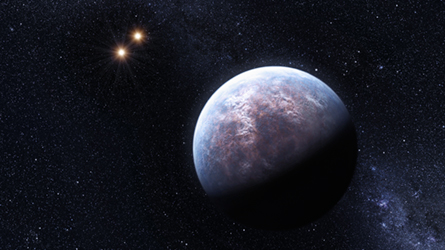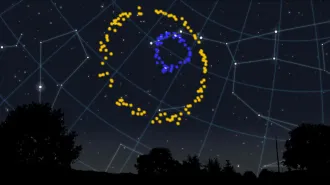About half of all sunlike stars host light-weight planets that are less than three times Neptune’s mass. And some of these orbs may be only a few times heavier than Earth.

That’s the conclusion of a team of European astronomers who have announced the discovery of 32 additional planets beyond the solar system, bringing the total of known extrasolar planets to more than 400.
“These low-mass planets are everywhere,” notes team member Stéphane Udry of Geneva Observatory in Sauverny, Switzerland. “Models are predicting them and we are finding them.”.
The new mother lode increases by about 30 percent the number of low-mass planets — those with a mass of less than 20 Earth masses — Udry says.
He and his colleagues reported the findings on October 19 at a conference on extrasolar planets at the University of Porto in Portugal. Udry says his team expects to announce the discovery of another 30 or so extrasolar planets within the next six months.
“All I can say is, ‘Wow. What a bonanza of planets,” says theorist Sara Seager of MIT, who is not a member of the discovery team.
The new roster of planets includes six planets classified as superEarths, so named because they have a mass five to 10 times that of Earth. Udry says his team identified several of the superEarths by scrutinizing the motion of stars already known to have heavier planets, rather than by blindly looking for low-mass planets.
“This proves that [superEarths] are very common. Even if you are not looking for them, you are finding them,” says Udry. SuperEarths — at least those in the short-period orbits that surveys have been able to detect — appear to be at least three times more common than giant, Jupiterlike planets, he adds.
That dovetails with the finding, reported last year by Udry and his colleagues using a smaller data set, that as many as 30 percent of all sunlike stars may harbor short-period superEarths (SN: 7/5/08, p. 7).
“To find one more superEarth, this is not the important point,” says Udry. Rather, his team is trying to extract from the new numbers exactly how common superEarths and Earth-mass planets are, a task for which NASA’s Kepler mission, launched earlier this year, may provide the best results.
Udry adds that the data indicate that the general rules of planet formation, deduced by analyzing the much larger population of heavy, Jupiterlike planets, can be successfully applied to the lower-mass population.
Many of the low-mass planets in the new study orbit M dwarfs, low-mass stars that are the most common star type in the universe. Theoretical calculations predict that low-mass planets would be common around such stars. According to theory, these low-weight stars are thought to have a hard time making heavy planets because the disks of gas and dust these stars generated in their youth — the raw material for making planets — might not contain enough material.
But while the new discoveries do show low-mass stars as being relatively common, two of the new-found planets that also orbit M dwarfs are heavier than Jupiter — possibly challenging that planet formation theory, said study collaborator Nuno Santos of the University of Porto.
“It’s premature to say theory needs to be modified,” says Seager. “We need larger numbers of planetary cases we don’t expect.”
Three of the new-found planets, each several times heavier than Jupiter, orbit stars that have a low abundance of any element heavier than helium. Previous searches have indicated that such stars, which in astronomical parlance are labeled “metal-poor,” are much less likely to form heavy planets. The findings suggest that it may not be quite as difficult for metal-poor stars to produce these heavyweights as previously thought, says Udry.
To find the orbs, Udry and his colleagues examined the motion of some 2,000 nearby stars over the past five years. The team used the High Accuracy Radial Velocity Planet Searcher spectrometer on the European Southern Observatory’s 3.6-meter telescope at La Silla in Chile. A tiny wobble in a star’s motion indicates the tug of an unseen, orbiting planet. The HARPS instrument can detect variations in a star’s motion along the line of sight to Earth as small as 3.5 kilometers an hour, the pace of a person walking slowly.
These measurements provide only the minimum mass of an orbiting planet, not its actual mass. However, statistics suggest that with among such a large number of planets, many are likely to have a mass close to their minimum, Udry says.
Udry says his team will now examine the planetary systems with NASA’s Spitzer Space Telescope to see if any of these planets pass across the face of their parent stars, as observed from Earth. The minieclipses created by such passages reveal their size and, in conjunction with the wobble method, their exact mass.







